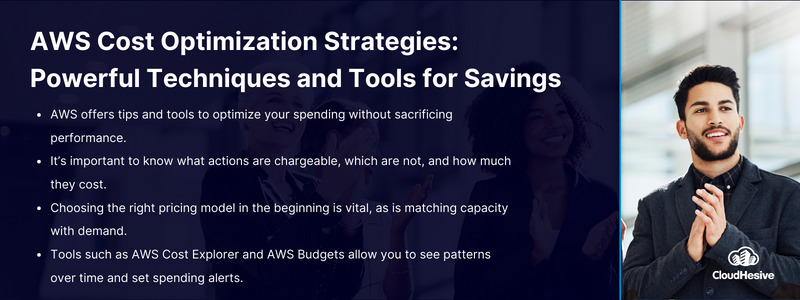Employ these best practices to get the most out of AWS without compromising quality and spending more than you have to.

Amazon Web Services (AWS) is the number one cloud provider that is easy to use, flexible, scalable, reliable, secure, and cost-effective. The last benefit – cost-effectiveness – requires optimizing spending while getting the capacity and performance you need.
AWS cost optimization strategies are helped with flexible purchase options, resource provisioning, discounts with savings plans, and tools to ensure you’re only paying for what you use. Several cloud financial management optimization services round things out with cost explorer, computer optimizer, and savings plan recommendations.
When you optimize costs for AWS, you free up money that can be spent on improving existing applications or financing a project that will better serve your customers’ needs. In this article, you’ll get:
- A better understanding of the AWS cost structure
- Best practices to optimize costs
- AWS cost optimization tools and advanced techniques
- Address security implications in cost optimization
Understanding the AWS cost structure
AWS has a pay-as-you-go approach for most of its cloud services. You pay for the individual services you consume as you are using them. There are no termination fees. Some services are free, such as Amazon CloudWatch, which lets you monitor your applications and infrastructure. Others, like the Internet of Things and Amazon Augmented AI, have free trials and monthly fees.
AWS’s three fundamental cost drivers are compute, storage, and outbound data transfer.
- There is usually no charge for inbound data transfer or data transfer between other AWS services within the same region.
- Outbound data transfer is aggregated across services and then charged at the outbound data transfer rate, and the more data you transfer, the lower the per GB cost.
- For compute resources, you pay by the hour or the second from launching a resource until you stop or terminate it, unless you have made a reservation with a previously agreed-upon cost. Beforehand
- For data storage and transfer, you pay per GB.
It pays to start early with cost optimization. The AWS cloud means you trade fixed expenses (for data centers and physical servers) for variable expenses. This means you only pay for what you consume. AWS has a set of solutions to help you manage and optimize your spending with services, tools, and resources to organize and track cost and usage, enhance control with consolidated billing and access permission, enable better planning with budgeting and forecasts, and further decrease cost with resources and pricing optimizations.
8 best practices for AWS cost optimization
With AWS, you can control costs and optimize your spending while getting everything required to meet performance and capacity.
1. Begin by choosing the right pricing model. You can use reserved instances to reduce Redshift, ElastiCache, and OpenSearch service costs. You can save up to 72% with reserved instances over on-demand capacity.
2. Match capacity with demand by stopping or downsizing EC2 instances. Use AWS Instance Scheduler to automatically stop instances and AWS Operations Conductor to automatically resize the Amazon EC2 instances.
3. Use the Trusted Advisor Amazon RDS Idle DB instances check to identify DB instances that have not had any connection over the last seven days. Stop these DB instances using the automation steps described here: Implementing DB Instance Stop and Start in Amazon RDS to save money.
4. For Redshift, use the Trusted Advisor Underutilized Redshift clusters check to identify clusters with no connections for the last seven days and less than 5% cluster-wide average CPU utilization for 99 percent of the last seven days. To reduce costs, pause these clusters using the steps in lower your costs with the new pause and resume actions on Amazon Redshift.
5. Analyze your DynamoDB usage by monitoring Consumed Read Capacity Units and Consumed Write Capacity Units in CloudWatch. To automatically scale (in and out) your DynamoDB table, use the AutoScaling feature. Using the steps at Enabling DynamoDB auto scaling on existing tables, enable AutoScaling on your existing tables. Alternatively, you can use the on-demand option to pay-per-request for read and write requests so that you only pay for what you use to easily balance costs and performance.
6. Identify resource waste. Amazon EBS volumes with very low activity (less than one IOPS per day) over seven days indicate they are probably not in use. Identify these volumes using the Trusted Advisor Underutilized Amazon EBS Volumes Check. To reduce costs, first snapshot the volume and then delete these volumes. You can automate the creation of snapshots using the Amazon Data Lifecycle Manager. Follow the steps at Delete an Amazon EBS volume to delete the volumes.
7. Analyze S3 usage. Use Amazon S3 analytics to analyze storage access patterns on the object data set for 30 days or longer. Amazon S3 Analytics recommends leveraging S3 Infrequently Accessed (S3 IA) to reduce costs. You can automate moving these objects into a lower-cost storage tier using lifecycle policies. Alternatively, you can also use S3 Intelligent Tiering, which automatically analyzes and moves your objects to the appropriate storage tier.
8. Review networking. The Trusted Advisor Idle Load Balancers check offers a report of load balancers with a RequestCount of less than 100 over the past seven days. You can use Step 8: Delete your load balancer to reduce costs. And use the steps provided in Using AWS Cost Explorer to analyze data transfer costs to review your data transfer costs using Cost Explorer.
AWS Cost Optimization Tools
AWS offers a comprehensive set of tools for reporting and help with cost optimization. These include:
- With AWS Cost Explorer, you can see patterns in AWS spending over time, predict future costs, identify areas that need closer examination, observe Reserved Instance utilization, observe Reserved Instance coverage, and receive Reserved Instance recommendations.
- The AWS Trusted Advisor gives you real-time identification of areas for potential optimization.
- Use AWS Budgets to set custom budgets that trigger alerts when cost or usage exceed – or are forecasted to exceed – your budgeted amount. You can also set budgets based on tags, accounts, and resource types.
- Amazon CloudWatch can collect and track metrics, monitor log files, set alarms, and automatically react to changes in AWS resources.
- With AWS CloudTrail, you can log, continuously monitor, and retain account activity related to actions across AWS infrastructure at a low cost.
- Automate analysis and visualization of Amazon S3 storage patterns to help you decide when to shift data to a different storage class with Amazon S3 Analytics.
- The AWS Cost and Usage Report offers Granular raw data files detailing your hourly AWS usage across accounts used to determine which Amazon S3 bucket is driving data transfer spend. The AWS Cost and Usage Report has dynamic columns that populate depending on the services you use.
Advanced AWS cost optimization techniques
You can also use some advanced techniques to optimize costs, including reserved instances and spot instances:
- Amazon Spot Instances reduce Amazon EC2 costs, Compute Savings Plans reduce Amazon EC2, Fargate, and Lambda costs, and the SageMaker Savings Plans reduce SageMaker costs.
- AWS Auto Scaling monitors applications and automatically adjusts capacity that maintains steady, predictable performance with the lowest possible cost, and it’s easy to use within the AWS Management Console.
- Data transfer cost optimization can be achieved through
- Limiting outbound data transfer
- Keeping all your data in the same region
- Avoiding transfers across availability zones
- Use the AWS regions with the lowest data costs
- Avoid public IP addresses, which carry a higher data transfer cost
- Use Amazon CloudFront to minimize data transfer costs on the internet
You can also utilize Cost Explorer and cost allocation tags to discover how your data is being used and the fees incurred. Use Cost Explorer to identify high-cost transfers and cost allocation tags to filter data transfers by type.
In addition, the AWS Well-Architected Framework helps you understand decisions when building workloads on AWS, providing architectural best practices to design reliable, secure, efficient, cost-effective, and sustainable workloads. It also shows a way to consistently measure your architecture against best practices and identify areas for improvement.
Security considerations in AWS cost Optimization
Security is always a top priority and a shared responsibility:
- Security of the cloud is an AWS responsibility. This means AWS is responsible for protecting the infrastructure that runs AWS services in the AWS Cloud and provides you with services that you can use securely.
- Security in the cloud. Your responsibility is determined by the AWS service that you use. You are also responsible for other factors, including the sensitivity of your data, your company’s requirements, and applicable laws and regulations.
This means that you are responsible for protecting your data security as you transfer it to or from the cloud. Recommendations for secure and cost-effective data transfer and deployments include:
- Use multi-factor authentication (MFA) for each account.
- Use SSL/TLS to communicate with AWS resources. AWS requires TLS 1.2 and recommends TLS 1.3.
- Set up API and user activity logging with AWS CloudTrail.
- Use AWS encryption solutions, along with all default security controls within AWS services.
- Use advanced managed security services like Amazon Macie to assist in discovering and securing sensitive data stored in Amazon S3.
- Use a FIPS endpoint if you require FIPS 140-2 validated cryptographic modules when accessing AWS through a command line interface or an API. For more information about the available FIPS endpoints, see Federal Information Processing Standard (FIPS) 140-2
AWS offers plenty of tips and tools to help you implement AWS cost implementation strategies, from how to get started optimizing costs from the get-go to CloudWatch, so you can collect and track the critical metrics for further cost savings.
To get the most out of AWS at the lowest cost, a managed services provider with deep experience in AWS can help you make better decisions, by helping you identify areas to save, as well as improve the quality of your data so you spend less money and time transferring data.
CloudHesive is a cloud solutions consulting and managed service provider with expertise in all things Amazon Web Services. We have eight AWS Competencies, more than 50 AWS Certifications, and membership in nine Partner Programs.
We have the knowledge and experience to help your business realize all the benefits AWS cloud offers, as well as associated services such as AWS customer service solutions and Amazon Risk Detection.
We’ve helped more than 100 companies reduce their operating costs and increase productivity with our focus on security, reliability, availability, and scalability. With 9 years of experience, we leverage cloud-based technology to its full potential. Contact the CloudHesive team today.



